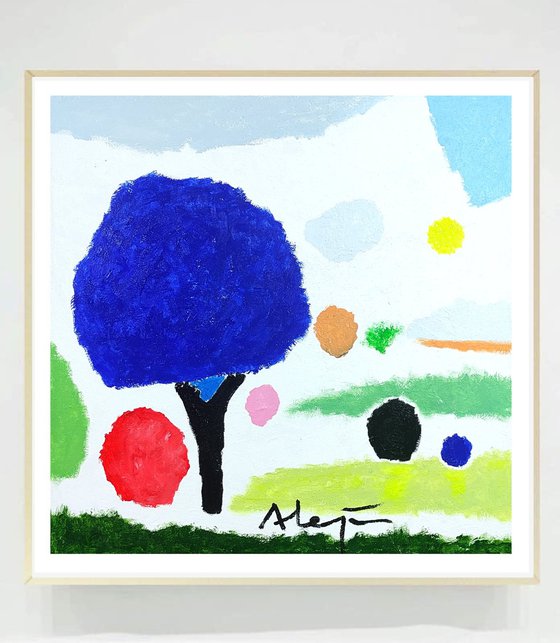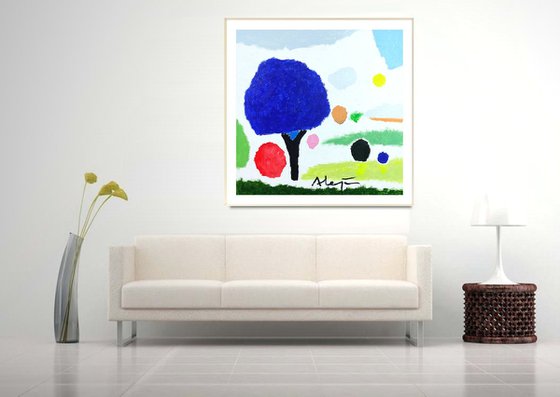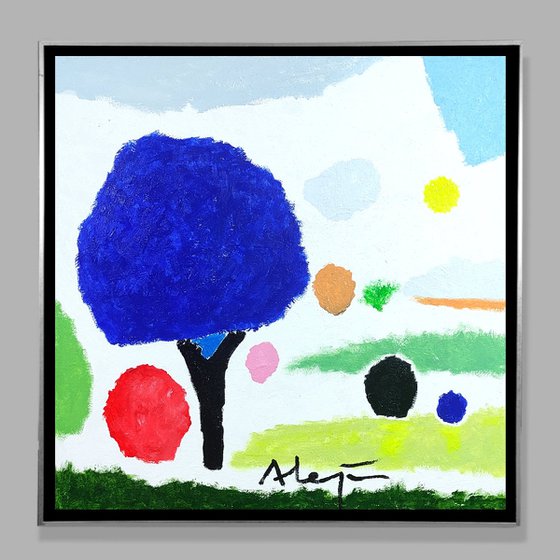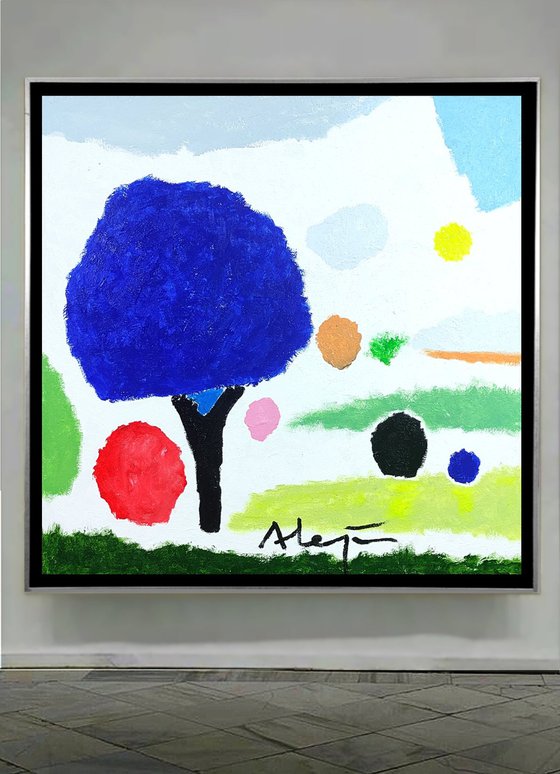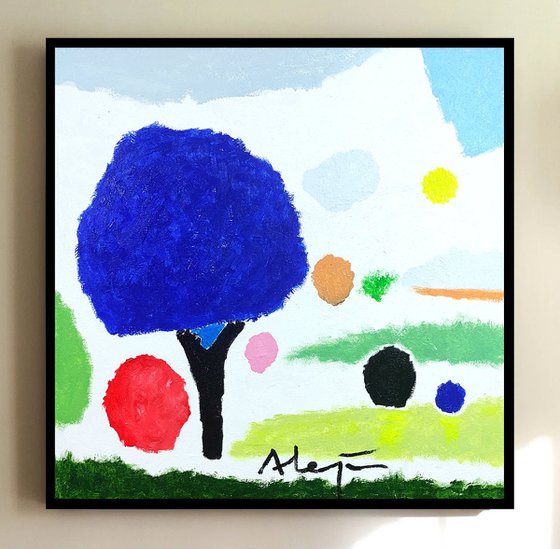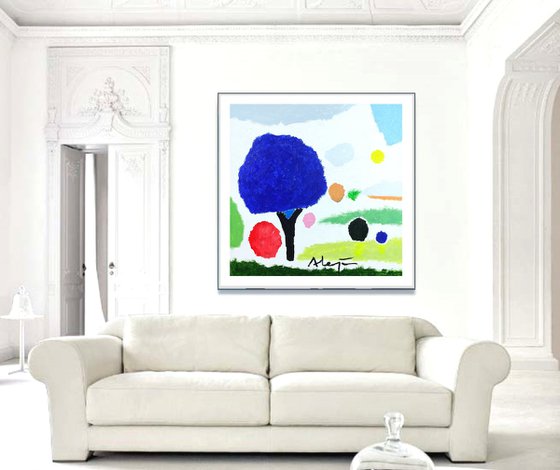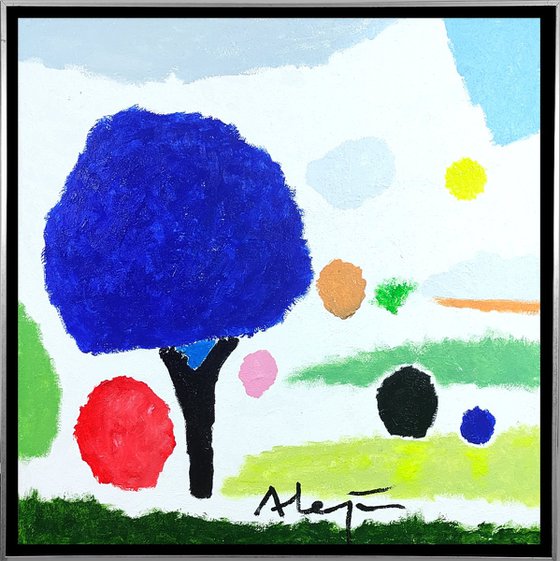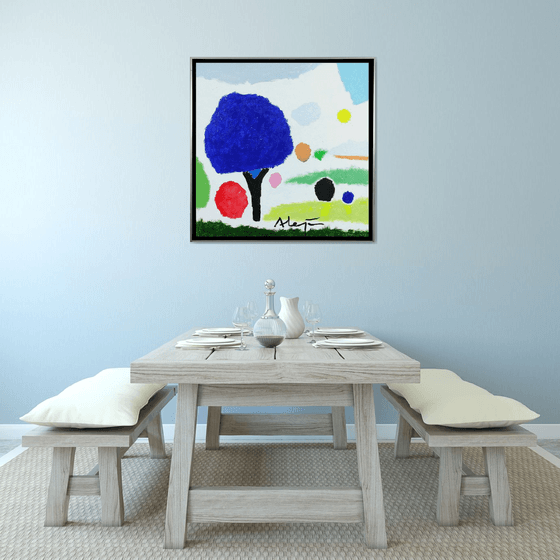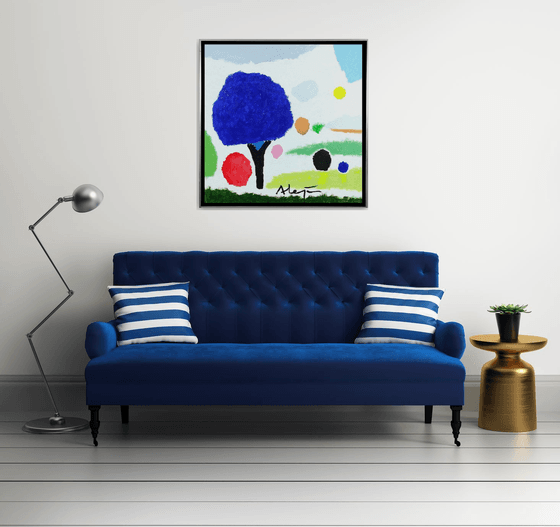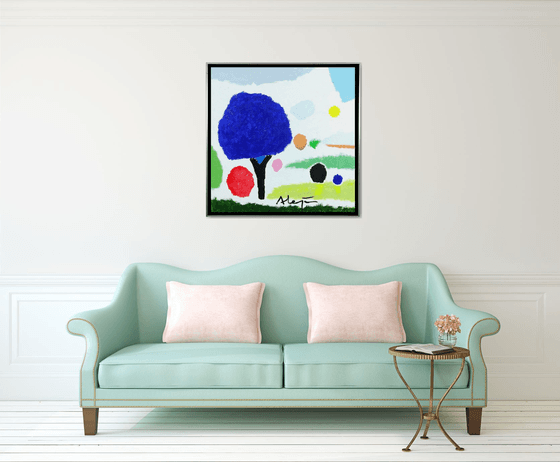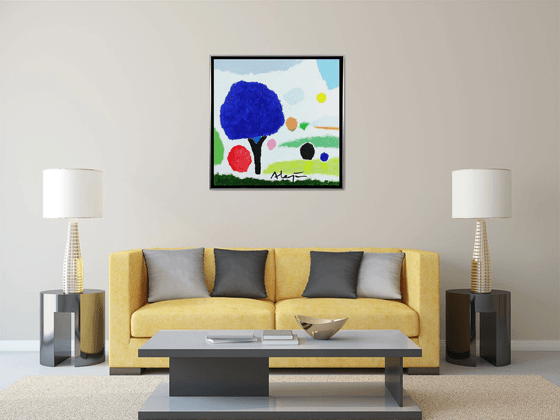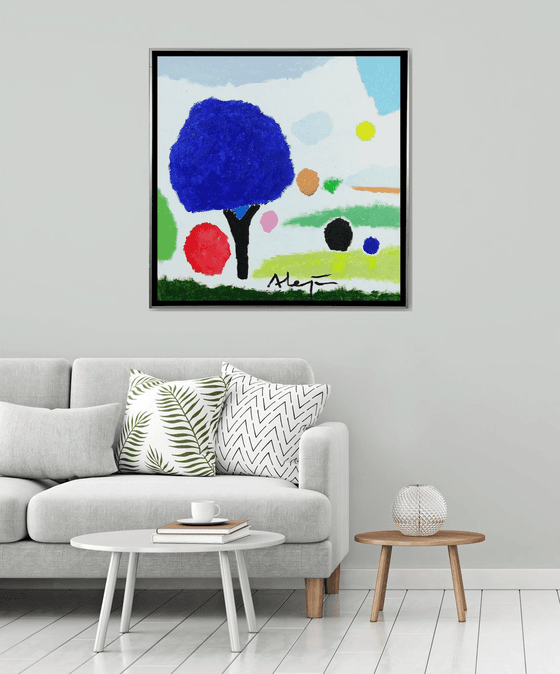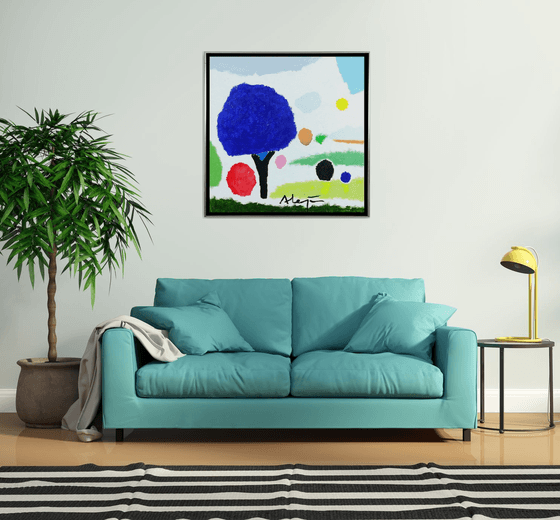Main Navigation
Original artwork description:
This artwork belongs to a new series called "Natural Flags", they are landscapes of more or less abstract shapes on a white background because it represents a dawn, a new way of seeing things, life.
It's titled “Pro Vinci Landscape” and it is a symbolic landscape, that is, it is and is not a landscape.
In the artwork we can see a tree in the foreground. A tree (or a cat-umbrella head) with blue leaves, like blue although the clouds and moon that rise above it are lighter. Some relationship must exist between them. The tree has a couple of branches and a black trunk. And between the branches we see an inverted triangular area also in blue, although lighter than the blue of the tree. This inverted triangle shape can evoke, if this landscape is not a plan view, the delta of a river.
On the sides of the tree we can see some fields in three shades of green, as well as some bushes with individual characteristics, both in shape, size, color and most importantly: how the sand is under the color. defines some features within those spots of color. I like that it is the sand that paints with its strokes and textures, defining the interior shapes and not the brush with different shades or colors mixed or superimposed. If I choose the shapes, their sizes, shapes and colors, the sand is what defines what the edges are like as well as the figures (along with the light, depending on how it affects the painting) that appear within the shapes if we look closely. a good while and let our imagination fly.
One could say, then, that this is a half-finished painting, since it is the observer who ends up creating the scene in his mind, mixing aesthetic and intellectual beauty to achieve that spiritual elevation that they say art contributes, as if they were wings that come out of our heads.
Regarding the title of the work, it is based, as well as the work, on a work by Nicolas de Staël, a painter that I discovered this summer and who painted landscapes and abstract still lifes with a palette knife. I like to paint with a spatula because it even makes the paint take shapes that the brush traces more precisely, although I prefer for these landscapes to use a brush like someone who puts their hand in the sand and feels a kind of caress. With the spatula it wouldn't be the same. The spatula has more, due to its metallic material, than a knife or sword and that is why I do not usually use it.
The title of Staël's artwork is “Landscape of Provence.” I have modified it because I like to play with words and look for their etymology. In this case it is a simple game, I divide the word Provence into “Pro” and “Vence" (To win, in Latin: Vici), with the result that this is a landscape, not of Provence, although at its base it was, but which is a landscape of pro vinci, that is, a landscape of the province that helps us win. And to win what? Perhaps certain limits like those of that kind of membrane that I believe must be enveloping our mind, an invisible membrane like the mind is, but as we grow it becomes harder and more rigid, making it less permeable to passage. of sensations and ideas that stimulate the imagination. That's why I also use a brush, because I don't think the solution is to tear a canvas or a membrane, but rather to treat it with respect and affection, because it helps us reach certain places, to come to them, to see and perhaps to conquer. , as a Roman emperor said years ago. It is also a tribute to Leonardo, who studied nature very closely.
It has painted edged, there´s no need to frame it, but it´s recommended.
Materials used:
Acrylic
Tags:
#landscape #nature #fields #tree #river #horizon #colorful #minimal #impressionist #pop #positive #ecological #alejosFeatured by our Editors:
Pro Vinci Landscape (2023) Acrylic painting
by Alejos
18 Artist Reviews
£1,702.16
- Acrylic painting on Canvas
- One of a kind artwork
- Size: 100 x 100 x 2cm (unframed)
- Ready to hang
- Signed on the front
- Style: Impressionistic
- Subject: Landscapes, sea and sky
Loading
Original artwork description
This artwork belongs to a new series called "Natural Flags", they are landscapes of more or less abstract shapes on a white background because it represents a dawn, a new way of seeing things, life.
It's titled “Pro Vinci Landscape” and it is a symbolic landscape, that is, it is and is not a landscape.
In the artwork we can see a tree in the foreground. A tree (or a cat-umbrella head) with blue leaves, like blue although the clouds and moon that rise above it are lighter. Some relationship must exist between them. The tree has a couple of branches and a black trunk. And between the branches we see an inverted triangular area also in blue, although lighter than the blue of the tree. This inverted triangle shape can evoke, if this landscape is not a plan view, the delta of a river.
On the sides of the tree we can see some fields in three shades of green, as well as some bushes with individual characteristics, both in shape, size, color and most importantly: how the sand is under the color. defines some features within those spots of color. I like that it is the sand that paints with its strokes and textures, defining the interior shapes and not the brush with different shades or colors mixed or superimposed. If I choose the shapes, their sizes, shapes and colors, the sand is what defines what the edges are like as well as the figures (along with the light, depending on how it affects the painting) that appear within the shapes if we look closely. a good while and let our imagination fly.
One could say, then, that this is a half-finished painting, since it is the observer who ends up creating the scene in his mind, mixing aesthetic and intellectual beauty to achieve that spiritual elevation that they say art contributes, as if they were wings that come out of our heads.
Regarding the title of the work, it is based, as well as the work, on a work by Nicolas de Staël, a painter that I discovered this summer and who painted landscapes and abstract still lifes with a palette knife. I like to paint with a spatula because it even makes the paint take shapes that the brush traces more precisely, although I prefer for these landscapes to use a brush like someone who puts their hand in the sand and feels a kind of caress. With the spatula it wouldn't be the same. The spatula has more, due to its metallic material, than a knife or sword and that is why I do not usually use it.
The title of Staël's artwork is “Landscape of Provence.” I have modified it because I like to play with words and look for their etymology. In this case it is a simple game, I divide the word Provence into “Pro” and “Vence" (To win, in Latin: Vici), with the result that this is a landscape, not of Provence, although at its base it was, but which is a landscape of pro vinci, that is, a landscape of the province that helps us win. And to win what? Perhaps certain limits like those of that kind of membrane that I believe must be enveloping our mind, an invisible membrane like the mind is, but as we grow it becomes harder and more rigid, making it less permeable to passage. of sensations and ideas that stimulate the imagination. That's why I also use a brush, because I don't think the solution is to tear a canvas or a membrane, but rather to treat it with respect and affection, because it helps us reach certain places, to come to them, to see and perhaps to conquer. , as a Roman emperor said years ago. It is also a tribute to Leonardo, who studied nature very closely.
It has painted edged, there´s no need to frame it, but it´s recommended.
Materials used:
Acrylic
Tags:
#landscape #nature #fields #tree #river #horizon #colorful #minimal #impressionist #pop #positive #ecological #alejosFeatured by our Editors:
14 day money back guaranteeLearn more
